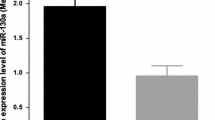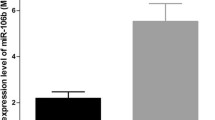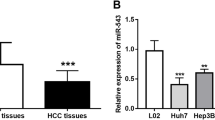Abstract
Hepatocellular carcinoma (HCC) has a high dead rate partly due to late diagnosis. This study aimed to investigate the prognostic value of miR-937 in HCC and its role in the HCC progression. HCC tissue and adjacent non-cancerous tissues (NCT) (n = 125) were detected about the expression level of miR-937 via real-time quantitative PCR. The relationship between miR-937 expression and each important clinical characteristic was evaluated. And the prognostic significance of miR-937 was assessed by Kaplan–Meier curve and Cox regression analysis. CCK-8 and Transwell assays were conducted to observe the effects of miR-937 on HCC cell proliferation, migration, and invasion. The miR-937 expression was upregulated in HCC tissues, as well as in HCC cell lines. The upregulation of miR-937 showed a significant association with lymph node metastasis and TNM stage. Upregulation of miR-937 predicted poor prognosis of HCC patients. Overexpression of miR-937 promoted HCC cell ability of proliferation, migration, and invasiveness, while knockdown of miR-937 inhibited these cellular behaviors. miR-937 expression was upregulated in HCC and may serve as a promising prognostic factor and treated target for HCC patients. miR-937 might exert a promoter role in HCC through accelerated tumor cell proliferation, migration, and invasion.





Similar content being viewed by others
References
Forner, A., Reig, M., & Bruix, J. (2018). Hepatocellular carcinoma. Lancet (London, England)., 391(10127), 1301–1314.
Hartke, J., Johnson, M., & Ghabril, M. (2017). The diagnosis and treatment of hepatocellular carcinoma. Seminars in Diagnostic Pathology, 34(2), 153–159.
Grandhi, M. S., Kim, A. K., Ronnekleiv-Kelly, S. M., Kamel, I. R., Ghasebeh, M. A., & Pawlik, T. M. (2016). Hepatocellular carcinoma: From diagnosis to treatment. Surgical Oncology, 25(2), 74–85.
Ren, Z., Ma, X., Duan, Z., & Chen, X. (2020). Diagnosis, therapy, and prognosis for hepatocellular carcinoma. Analytical Cellular Pathology (Amsterdam)., 2020, 8157406.
Lu, T. X., & Rothenberg, M. E. (2018). MicroRNA. The Journal of Allergy and Clinical Immunology, 141(4), 1202–1207.
Mohr, A. M., & Mott, J. L. (2015). Overview of microRNA biology. Seminars in Liver Disease, 35(1), 3–11.
Ying, S. Y., Chang, D. C., & Lin, S. L. (2008). The microRNA (miRNA): Overview of the RNA genes that modulate gene function. Molecular Biotechnology, 38(3), 257–268.
Li, X., Zeng, Z., Wang, J., Wu, Y., Chen, W., Zheng, L., et al. (2020). MicroRNA-9 and breast cancer. Biomedicine & Pharmacotherapy [Biomedecine & Pharmacotherapie], 122, 109687.
Lopez-Pedrera, C., Barbarroja, N., Patiño-Trives, A. M., Luque-Tévar, M., Torres-Granados, C., Aguirre-Zamorano, M. A., et al. (2020). Role of microRNAs in the development of cardiovascular disease in systemic autoimmune disorders. International Journal of Molecular Sciences. https://doi.org/10.3390/ijms21062012
Chen, F., Li, X. F., Fu, D. S., Huang, J. G., & Yang, S. E. (2017). Clinical potential of miRNA-221 as a novel prognostic biomarker for hepatocellular carcinoma. Cancer Biomarkers: Section A of Disease Markers, 18(2), 209–214.
Rashad, N. M., El-Shal, A. S., Shalaby, S. M., & Mohamed, S. Y. (2018). Serum miRNA-27a and miRNA-18b as potential predictive biomarkers of hepatitis C virus-associated hepatocellular carcinoma. Molecular and Cellular Biochemistry, 447(1–2), 125–136.
Shi, J., Li, X., Hu, Y., Zhang, F., Lv, X., Zhang, X., et al. (2020). MiR-1203 is involved in hepatocellular carcinoma metastases and indicates a poor prognosis. Neoplasma, 67(2), 267–276.
Shi, B., Zhang, X., Chao, L., Zheng, Y., Tan, Y., Wang, L., et al. (2018). Comprehensive analysis of key genes, microRNAs and long non-coding RNAs in hepatocellular carcinoma. FEBS Open Bio, 8(9), 1424–1436.
Li, Z., Lou, Y., Tian, G., Wu, J., Lu, A., Chen, J., et al. (2019). Discovering master regulators in hepatocellular carcinoma: One novel MR, SEC14L2 inhibits cancer cells. Aging, 11(24), 12375–12411.
Carvalho de Oliveira, J., Molinari Roberto, G., Baroni, M., Bezerra Salomão, K., Alejandra Pezuk, J., & Sol Brassesco, M. (2018). MiRNA dysregulation in childhood hematological cancer. International Journal of Molecular Sciences. https://doi.org/10.3390/ijms19092688
Harrandah, A. M., Mora, R. A., & Chan, E. K. L. (2018). Emerging microRNAs in cancer diagnosis, progression, and immune surveillance. Cancer Letters, 438, 126–132.
Qadir, M. I., & Rizvi, S. Z. (2017). miRNA in hepatocellular carcinoma: pathogenesis and therapeutic approaches. Critical Reviews in Eukaryotic Gene Expression., 27(4), 355–361.
Nagy, Á., Lánczky, A., Menyhárt, O., & Győrffy, B. (2018). Validation of miRNA prognostic power in hepatocellular carcinoma using expression data of independent datasets. Scientific Reports, 8(1), 9227.
Li, S., Yao, J., Xie, M., Liu, Y., & Zheng, M. (2018). Exosomal miRNAs in hepatocellular carcinoma development and clinical responses. Journal of Hematology & Oncology., 11(1), 54.
Li, D., Zhang, J., & Li, J. (2020). Role of miRNA sponges in hepatocellular carcinoma. Clinica Chimica Acta, 500, 10–9.
Clark, T., Maximin, S., Meier, J., Pokharel, S., & Bhargava, P. (2015). Hepatocellular carcinoma: Review of epidemiology, screening, imaging diagnosis, response assessment, and treatment. Current Problems in Diagnostic Radiology, 44(6), 479–486.
Nishikawa, H., Arimoto, A., Wakasa, T., Kita, R., Kimura, T., & Osaki, Y. (2013). Comparison of clinical characteristics and survival after surgery in patients with non-B and non-C hepatocellular carcinoma and hepatitis virus-related hepatocellular carcinoma. Journal of Cancer, 4(6), 502–513.
Tietze, L., & Kessler, S. M. (2020). The good, the bad, the question-H19 in hepatocellular carcinoma. Cancers. https://doi.org/10.3390/cancers12051261
Zhang, T. Q., Su, Q. Q., Huang, X. Y., Yao, J. G., Wang, C., Xia, Q., et al. (2018). Micro RNA-4651 serves as a potential biomarker for prognosis when selecting hepatocellular carcinoma patients for postoperative adjuvant transarterial chemoembolization therapy. Hepatology Communications, 2(10), 1259–1273.
D’Anzeo, M., Faloppi, L., Scartozzi, M., Giampieri, R., Bianconi, M., Del Prete, M., et al. (2014). The role of micro-RNAs in hepatocellular carcinoma: From molecular biology to treatment. Molecules (Basel, Switzerland)., 19(5), 6393–6406.
Liu, H., Ma, L., Wang, L., & Yang, Y. (2019). MicroRNA-937 is overexpressed and predicts poor prognosis in patients with colon cancer. Diagnostic pathology., 14(1), 136.
Li, D., Zhong, J., Zhang, G., Lin, L., & Liu, Z. (2019). Oncogenic role and prognostic value of microRNA-937-3p in patients with breast cancer. OncoTargets and Therapy, 12, 11045–11056.
Zhang, L., Zeng, D., Chen, Y., Li, N., Lv, Y., Li, Y., et al. (2016). miR-937 contributes to the lung cancer cell proliferation by targeting INPP4B. Life Sciences, 155, 110–115.
Fujiwara, T., & Yada, T. (2013). miRNA-target prediction based on transcriptional regulation. BMC Genomics, 14(Suppl 2), S3.
Zhou, D., Dong, L., Yang, L., Ma, Q., Liu, F., Li, Y., et al. (2020). Identification and analysis of circRNA-miRNA-mRNA regulatory network in hepatocellular carcinoma. IET Systems Biology, 14(6), 391–398.
Eun, J. W., Seo, C. W., Baek, G. O., Yoon, M. G., Ahn, H. R., Son, J. A., et al. (2020). Circulating exosomal microRNA-1307-5p as a predictor for metastasis in patients with hepatocellular carcinoma. Cancers. https://doi.org/10.3390/cancers12123819
Acknowledgements
We deeply thanks to the help from Jinyun Li and Yan Wang (Department of Pathology, The Second Affiliated Hospital of Kunming Medical University) for the tissue pathological confirmation.
Author information
Authors and Affiliations
Contributions
All authors initiated and designed the work, analyzed the data, and wrote and revised the manuscript. All authors read and approved the final manuscript.
Corresponding authors
Ethics declarations
Conflict of interest
The authors declare that they have no conflict of interest.
Ethical Approval
The study was approved by the Ethics Committee of Affiliated Hospital of the Second Affiliated Hospital of Kunming Medical University.
Consent to Participate
Written informed consent was provided from each participant.
Additional information
Publisher's Note
Springer Nature remains neutral with regard to jurisdictional claims in published maps and institutional affiliations.
Supplementary Information
Below is the link to the electronic supplementary material.
Rights and permissions
About this article
Cite this article
Chen, Z., Zhang, Y. Upregulation of MicroRNA-937 Predicts a Poor Prognosis and Promotes Hepatocellular Carcinoma Cell Proliferation, Migration, and Invasion. Mol Biotechnol 64, 33–41 (2022). https://doi.org/10.1007/s12033-021-00388-7
Received:
Accepted:
Published:
Issue Date:
DOI: https://doi.org/10.1007/s12033-021-00388-7




